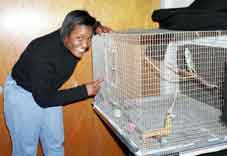Discounted Casualties:The Human Cost of Depleted Uranium, Part 1 <2> Battlefield tour – No mention of contamination
Apr. 5, 2000
Illness progressing, unable to work
An apartment in Berkeley, California. In a room fragrant with incense, Cassandra Garner (30) leafs through a photo album of her time in the Gulf War.
Charred bodies of Iraqi soldiers. American soldiers taking pictures of those bodies. Posing on an enemy tank destroyed by DU penetrators, the strong, taut figure of Garner herself.
Ten days after the ground war
"These pictures are from when I took a tour of the battlefield with the rest of my unit. We went along what they called the "Highway of Death" from Kuwait City to Basra, Iraq."
Garner and other soldiers from California went to Saudi Arabia in early February 1991. In a camp near the border, they joined other units guarding tens of thousands of Iraqi prisoners. About ten days after the war ended, in early March, the captain of her unit suggested, "Let's tour the battlefield to see what happened and what we can learn for the future."
"We were going to the battlefield. Shells wouldn't be flying back and forth, but we all wanted to see the front line. We were young and full of curiosity. We went out there all excited."
Huge numbers of Iraqi tanks, armored vehicles, and trucks still sat where they had been hit. Garner and her comrades ran around taking pictures, looking for battlefield souvenirs. They climbed repeatedly in and out of destroyed tanks. And they were joined by plenty of other "tourists" from other units.
Meanwhile, stirred up by wind or military boots, tiny DU particles dusting the surfaces of vehicles or lying on the desert sand floated once again through the air and into lungs.
"We were just kids. We weren't even sensitive to the tragic reality of these bodies, and we didn't know a thing about DU. We were just running around having a good time in a contaminated battlefield."
Garner was then assigned a duty more dangerous than the battlefield tour. In early May, when about 150 others in her unit were sent home, she and two men were transferred to another camp and assigned to wash tanks and armored vehicles to be taken back to the US.
"I still don't know why they chose me. In any case, I spent three weeks washing the desert dust out of US tanks and Iraqi tanks that had been pierced by DU penetrators. There were at least a hundred of them." When this assignment was finished, she went home at the end of May.
Four months in the Middle East
Garner's physical problems began while she was still in Saudi Arabia. "I had headaches, sore joints, extremely heavy periods... I'd never had anything like that before." That four-month stay in the Middle East utterly transformed her healthy 21-year-old body.
Her illnesses worsened every year. In 1993, she received a medical discharge from the army. While still in the service, she underwent surgery twice in the gynecology department at the military hospital. Her muscles and joints were so painful her body seemed to be burning. Completely unable to work, she was forced to depend on her mother Pearl (55), who lives nearby, her two brothers, and friends.
Government deception
"The first time I heard that DU might be dangerous was in 1997. And besides the DU, right after I was sent to the Middle East I was told to take some pills that I didn't even know the name of. When I think that those things might have something to do with my physical problems..." The feeling that she was deceived by the government and the military she trusted keeps growing.
"The US government is always talking to the rest of the world about human rights and justice and equality, right? But if they don't go by that at home, how can they talk that way to others?"
Her body invaded by a mysterious enemy, Garner has come to see the true nature of war and the deceptions perpetrated by her own country. She has learned a great deal about society and war in these past nine years, but "To tell the truth, I paid way too high a price for that education. No one can give that time back to me." Her eyes glistened and she looked up toward the ceiling.
(Originally published on April 5, 2000)









